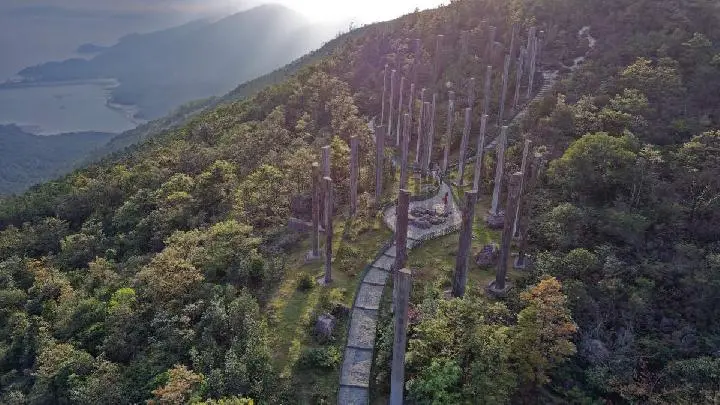Lifestyle-Health
Hong Kong’s Wisdom Path Closed Temporarily for Renovation Work

The Wisdom Path is one of Hong Kong’s destinations offering spiritual and natural tourism experiences. However, the Hong Kong Tourism Commission, or TC Hong Kong, announced on May 27, 2025, that the area will be temporarily closed.
The Hong Kong government website reports that Wisdom Path will be closed for renovation starting Thursday, June 5, 2025. During the renovation, visitors can enjoy the beautiful three-dimensional architectural landscape that harmoniously integrates with nature from various viewing points on the observation platform located in the Lantau Trail near the Wisdom Path.
Tourists can also scan the QR code on the observation platform, which will direct them to the Tourism Commission’s website to learn about the history and background of the Wisdom Path. Information about the location and photos of the observation deck are available on the website.
However, during the renovation, the tourist area will be opened gradually. The Tourism Commission will announce this through various channels to facilitate travel planning for residents and global tourists. The local government hopes that the renovation of this area will be completed in the fourth quarter of 2026.
History of the Wisdom Path
According to information from the Tourism Commission website, Wisdom Path was opened in 2005. The idea of establishing this area originated from Professor Jao Tsung-I, an internationally renowned teacher known for his academic and artistic achievements and research. He was inspired to create the monument of the Heart Sutra calligraphy after seeing the Buddha Stone carvings from the Vajracchedika Prajnaparamita Sutra on Mount Taishan, Shandong, China in 1980.
The Heart Sutra is a revered text among followers of Confucianism, Buddhism, and Taoism. Though it is written simply and concisely, its message is profound. Professor Jao Tsung-I completed his calligraphic work of the Heart Sutra in 2002.
He dedicated his work to the people of Hong Kong through the Hong Kong government in June 2002. The calligraphy was then reproduced in the form of large-scale wooden stelae. This resembles the bamboo slabs or zhuhian used for writing in ancient times. The stelae were erected on the slopes at the foot of Lantau Peak, near Ngong Ping.
Thirty-eight wooden stelae were arranged according to the Lantau landscape’s topography to reflect the profound meaning of the Heart Sutra. The arrangement in an eight-figure configuration symbolizes limitlessness. The columns at the highest point of the hill were left empty to signify the concept of “emptiness” (Sunyata), the main theme of the Heart Sutra.
The wooden stelae blend with nature, creating a unique, large-scale outdoor artwork. Visitors can appreciate the great work that combines art and philosophy when they are in a serene environment.
-

 Lifestyle-Health5 months ago
Lifestyle-Health5 months agoInvesting ₹10,000 a month via SIP in this mutual fund would have swelled to ₹1.71 crore in 21 years. Check how
-

 Lifestyle-Health5 months ago
Lifestyle-Health5 months agoMultibagger small-cap stock under ₹50 jumps despite sell-off in Indian stock market
-

 News In Diaspora5 months ago
News In Diaspora5 months agoHotels and homes on Crete evacuated as wildfire burns out of control
-

 Breaking News2 months ago
Breaking News2 months agoIsrael Names 77 Countries That Boycotted Netanyahu’s UN Speech In Protest Over Gaza War
-

 Lifestyle-Health6 months ago
Lifestyle-Health6 months agoOgie Alcasid’s daughter Leila ties the knot in Australia
-

 Lifestyle-Health5 months ago
Lifestyle-Health5 months agoDriving Abroad: These 34 countries accept SA licenses
-

 Politics6 months ago
Politics6 months agoFinally Federal Government of Nigeria Assures Citizens, Says The President Isn’t Controlled by Any Cabal
-

 Lifestyle-Health3 months ago
Lifestyle-Health3 months ago11 signs of growth that you might have missed
-

 Breaking News3 months ago
Breaking News3 months agoVeteran actress, Peju Ogunmola, loses only child, Ayomikun
-

 Lifestyle-Health6 months ago
Lifestyle-Health6 months ago10 Unwritten Rules for Visiting Bali that Travelers Should Know
-

 Lifestyle-Health3 months ago
Lifestyle-Health3 months agoWhen to take time off and focus on yourself and your family
-

 Lifestyle-Health5 months ago
Lifestyle-Health5 months agoAyala, UPC Renewables JV to sell stake in 1 GW projects in $600 mn deal

